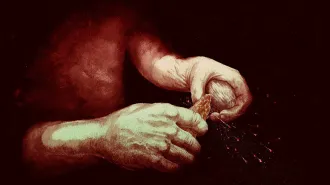Humans
Beauty found in the whites of the eyes, plus ancient fast food and hobbit teeth in this week’s news
Bronze Age fast food
Traditional, nutritious fast food may have existed for millennia before the invention of the drive-thru. Cereal grains found among the remains of two Bronze Age dwellings in Greece were cooked and ground into storable forms for quick, year-round meals, much as Greek villagers today do, says archaeologist Soultana Maria Valamoti of Aristotle University of Thessaloniki, Greece. Comparisons with processed cereals made by rural Grecians indicate that 4,000-year-old barley and wheat grains were boiled in either water or milk, dried, ground up and at one of the sites shaped into lumps, Valamoti will report in Archaeological and Anthropological Sciences. —Bruce Bower
Climate change of mind
British citizens who recently experienced flooding from intense rains express heightened concern about climate change. They also tend to view global warming as real and feel confident that they can take action to lessen climate trends, scientists report online March 20 in Nature Climate Change. These climate attitudes, as well as a strong willingness to conserve energy at home, contrast with views of participants who were spared flooding, say psychologist Alexa Spence of the University of Nottingham in England and her colleagues. Flooding and other environmental calamities present opportunities for public education about climate change research and energy conservation, the researchers say. —Bruce Bower
Hobbit tooth tiff
Even hobbits avoid the dentist. A study to appear in the American Journal of Physical Anthropology disputes an earlier claim that Homo floresiensis, the half-sized hominid from Indonesia, displays signs of having had dental work, including a filling — thus making it a modern human rather than a novel species. Imaging of hobbit teeth finds no evidence of artificial alterations, say anthropologists William Jungers of Stony Brook University Medical Center in New York and Yousuke Kaifu of the National Museum of Nature and Science in Tokyo. Patterns of tooth wear in two hobbits resemble those of hunter-gatherers and ancient Homo species, the researchers say. —Bruce Bower
Red-eye express
Individuals with reddened eyes quickly get perceived as sadder, less healthy and less physically alluring than those flashing the whites of their eyes, say psychologist Robert Provine of the University of Maryland, Baltimore County and his colleagues. In a series of five-second presentations, volunteers rated images of men’s and women’s eyes — some digitally reddened and others not — for sadness, health and attractiveness. The eye’s outer layer is white only in humans and has evolved to provide key social cues, perhaps explaining the popularity of eye drops as beauty aids, Provine’s team proposes online March 24 in Ethology. —Bruce Bower







